Table of Contents
ToggleStaying abreast of industry demands is crucial for professionals aiming to drive successful outcomes. Project Management Trends play a pivotal role in shaping the methodologies and tools employed in the field. One such trend that has gained significant traction is the adoption of PRINCE2 (Projects IN Controlled Environments) Certification. This blog explores how PRINCE2 aligns with current industry demands and why obtaining this certification is a strategic move for project management professionals.
Where does PRINCE2 work in Project Management Trends?
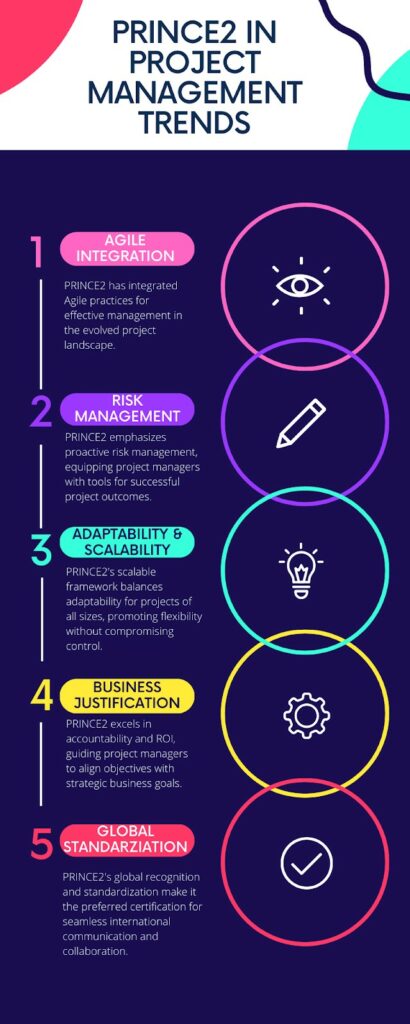
1. Agile Integration
Agile has reshaped project management, and PRINCE2 has adapted by integrating Agile practices. The PRINCE2 Agile certification seamlessly incorporates Agile principles, enabling effective management of dynamic projects.
2. Risk Management Emphasis
Project success often hinges on the ability to identify and mitigate risks effectively. PRINCE2 places a strong emphasis on risk management throughout the project lifecycle. By incorporating a well-defined risk management process, PRINCE2 equips project managers with the tools and methodologies to identify, assess, and manage risks proactively, ensuring projects stay on track and within scope.

3. Adaptability and Scalability
Every project is unique, and project management methodologies should be adaptable to varying project sizes and complexities. PRINCE2 provides a scalable framework that can be tailored to fit the specific needs of a project, promoting flexibility without compromising control. This adaptability makes PRINCE2 suitable for both small-scale projects and large, enterprise-level endeavors.
4. Focus on Business Justification
In an era where accountability and return on investment are paramount, PRINCE2 stands out for its unwavering commitment to business justification. The framework guides project managers in aligning project objectives with strategic business goals, ensuring that every project contributes to the organization’s overall success.
5. Standardization on a Global Scale
In a world where businesses are interconnected globally, standardization becomes crucial for seamless communication and collaboration. The PRINCE2 certification provides a universally acknowledged and standardized methodology for project management. Organizations across the globe appreciate the uniformity and clarity that PRINCE2 brings, establishing it as the certification of choice for professionals pursuing international opportunities or engaging in global collaborations.
Case study: Sony Corporation

Sony applied PRINCE2 Agile® to handle the improvement of their file-based workflow program. The project aimed to better meet the demands of the Media Solutions Department’s customers by enhancing the functionality of their existing system.
Using Sony’s Media Backbone Conductor and Navigator products, the initial project phases delivered a foundational infrastructure. Sony sought to further develop the product, identifying the need for a more adaptable approach to selecting and prioritizing features and ensuring continuous assessment of customer needs.
The Problem Sony Faced
The project’s initial phases involved a prolonged design period, software delivery, and deployment, occurring three to six months after agreed-upon requirements, with some changes during this period. Process and technology transformation aimed to achieve end-to-end file-based operation benefits, emphasizing stakeholder involvement, user community input, ROI measurement, and controlled changes. Success relied on cultivating a culture of continuous improvement, with a focus on enhancing content sharing and automating processes to prioritize core production activities.

The Solution needed to Guarantee
Continuous relevance of new developments to current business needs.
Flexibility to reprioritize upcoming software deliveries without requiring formal change requests or top management approvals.
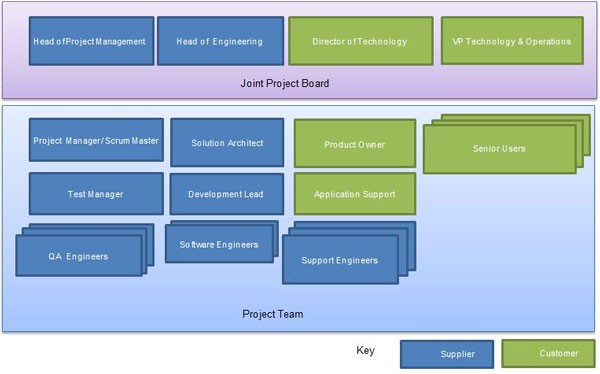
Image source: axelos.com
The image above shows the PRINCE2 project governance structure. For example, the Director of Technology effectively approved decisions around the backlog and was ultimately responsible for the acceptance of the product. The approach prioritized extensive user involvement, ensuring solutions directly addressed stakeholders’ business problems. Regular demos streamlined the user acceptance process, as stakeholders were familiar with and actively contributed to the product’s evolution throughout the project.
The development team used automated tools to support agile activities such as backlog management, progress tracking, and Kanban boards.
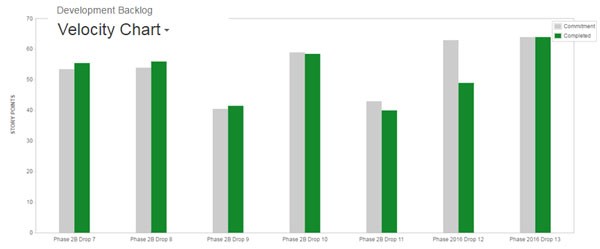
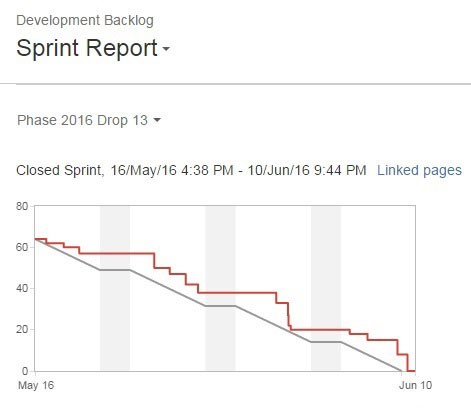
Image sources: axelos.com
Using PRINCE2 Agile at Sony has helped them handle changes more efficiently for users. This method has cut down on the extra work of change requests and assessments, allowing Sony to concentrate on delivering exactly what is required. This supports quicker acceptance of the delivery and a faster return to regular operations.
Case Study: NHS, UK
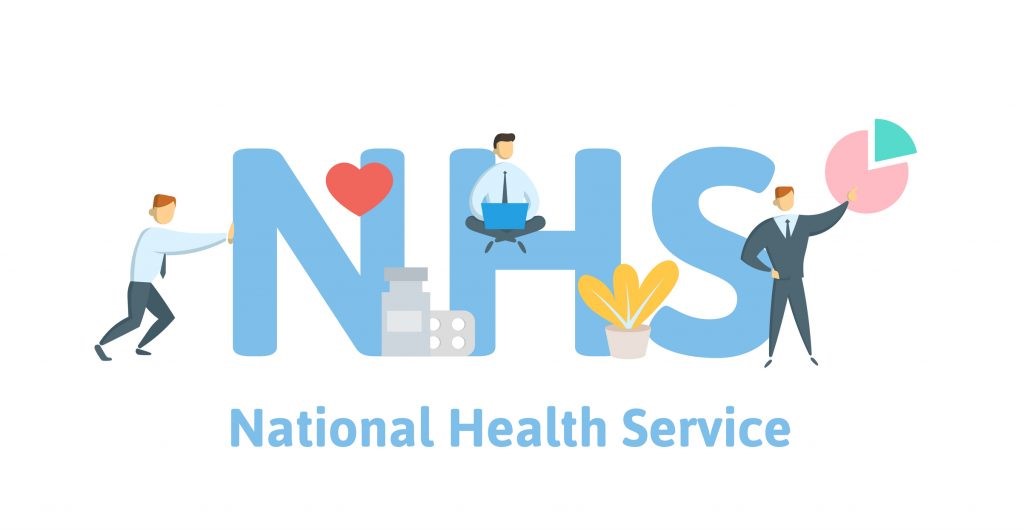
The NHS used PRINCE2 in different types of organizations on a variety of projects – service development, organizational change, clinical governance, PFI new build, and IT. The case study covers the use of PRINCE2 in these different contexts, implementation issues, lessons learned, and benefits gained.
The NHS often employs the PRINCE2® methodology to improve patient care delivery and implement transformative projects that impact learning pathways. The primary objectives are to ensure that public funds are utilized efficiently and that the quality of lifelong care remains high. Specifically, in controlled environments like IT, the use of PRINCE2® is mandatory and critical for the success of NHS business cases, especially for projects exceeding an approval value of £3 million. Moreover, NHS Services Scotland has adopted the PRINCE2® methodology to guide their solution-oriented projects related to the Emergency Care Summary (ECS) and Picture Archiving and Communications Systems (PACS).
Why PRINCE2 is applied in NHS?
PRINCE2 accomplishes this through:
- Distinguishing the management of project work from specialized contributions like design or construction.
- Facilitating the seamless integration of specialist aspects into the PRINCE2 method, which, when used in conjunction with PRINCE2, establishes a robust overall framework for project work.
- Emphasizing the description of what needs to be done rather than prescribing specific methods for every aspect of the project.
Conclusion
PRINCE2 Certification emerges as a strategic asset, aligning seamlessly with industry demands. Its adaptability, global recognition, emphasis on risk management, and focus on business justification make PRINCE2 a valuable investment for project management professionals seeking to advance their careers and contribute to the success of their organizations in an ever-changing business environment. As we look to the future, PRINCE2 certification remains a beacon guiding project managers toward excellence in project delivery.
